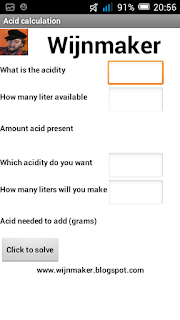Wijnmaker APP
Many years ago I started winemaking and for winemaking you need to do calculations for gaining the right amount of alcohol in your wine. Alcohol is made by yeast that consumes sugar ansd makes alcohol from it. For measuring the right amount sugar in your juice Specific Gravity (SG) is used.
During all these past years I develloped my own SG table which is now used by thousands of enthousiastic home winemakers.You can find all information by browsing through my WIJNMAKER weblog by clicking here.
A few weeks ago I found a very easy programming method to make your own Android APPs. It is called App-Inventor and supported by the MIT. I wrote about it before in the web-log here. So after examining several source codes I realised indeed how easy it was to make your own APP for Android. So I started wondering what to make. Well that was easy to find. I know from the emails I get and the posts on winemaking forums how much difficulties hobby winemakers have with calculating how much sugar to add when they are winemaking. Acid calculations are also sometimes problematic. Well that is all past-time. Here comes the Wijnmaker APP !!! You can install it on your android phone or tablet. It will work on both. No wifi aquired or even a data bundle. The app completely works off-line.
I did not post this on the Android Play store (I might later on) and it is only in English. But hey it works and most winemakers that are present on the internet read English.
So how do you install it.
Step 1
Go to your Android settings and look at your safety settings (for Android 4 up) or Apps (for earlier Android versions) and make sure that installing apps from unknown sources is allowed.
Step 2
Scroll down to the end of this page and click on download at the name of the file Wijnmaker_uk.apk Off course you need to do that on your phone or tablet and not on a windows, mac or linux machine.
Step 2 A
You can download the app on your desktop computer but then you have to manually transfer it to your Android machine. You can do that easily by using cloud-based storage utilities like Copy or Google Drive. I demonstrated that in my weblog: http://lucstechpage.weebly.com/blog/working-in-the-cloud
Step 3
Open your file browser from your apps (bestandsbeheer in Dutch) and go to the download folder on your SD card. There you will find the Wijnmaker_uk app. Click on it. Android than asks if you want to install it. Off course you want that !!!
Step 4
That's it. You can now put the App on your Android screen if you want. The app has its own unique icon that is familliar to the visitors of my weblog.
Some general thoughts.
First why no Desktop computer program.
Well that is easy. No winemaker with good sense puts a computer in his kitchen or winemaking room with all that water and sticky juices around. In no time accidents would happen. A tablet or phone is much more convenient.
Why didn't I put it on the Google Play store.
Well I am thinking about this. But, hey, these webpages are about technology so I presume you know how to install apps in Android.
You followed the abbove steps and don't understand anything about that.
Well then this is the wrong weblog for you. Search the net for information on installing android apps or find a friend who can help you.
Will there be an Iphone/Ipad version ??
Definitely !!! As soon as someone is donating me an Iphone and an Ipad I will be working on an Apple version. Not sooner as that. So if you want this App bad donate me enough money to buy these machines......... So show me the money ;)
Will you publish the sourcecode.
Well it is against all I stand for on these webpages and on my wijnmaker weblog but the answer is no. Why you ask. Well that is for safety reasons. I do not want anybody messing with the source code and altering the calculations that are in it. If that should happen and that person would spread the altered version around it could ruin wines made by hobbyists that would have downloaded the altered version.
Can I test the outcomes of the APP
Well sure you can. just go to my wijnmaker weblog and find some recipes. Look at the calculations done in those recipes and just fill the figures in, in the APP. That way you can check wether the outcomes of the calculations are the same.
Why is it free
I know. I know. I could have become multi-millionaire by selling this app on the Google playstore. But hey I am altruistic and a generally easy going guy. I never allowed advertisements on my wijnmaker.weblog and I do not do advertisements here. I am doing this for fun. It is not my job. I love open-source and open-hardware. I learn a lot every day. Having fun in making things is my reward.
And here it is:

























